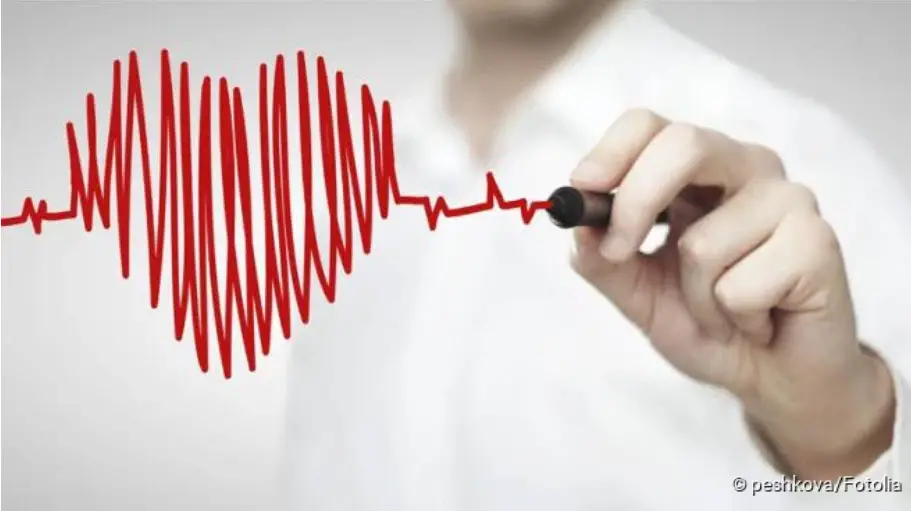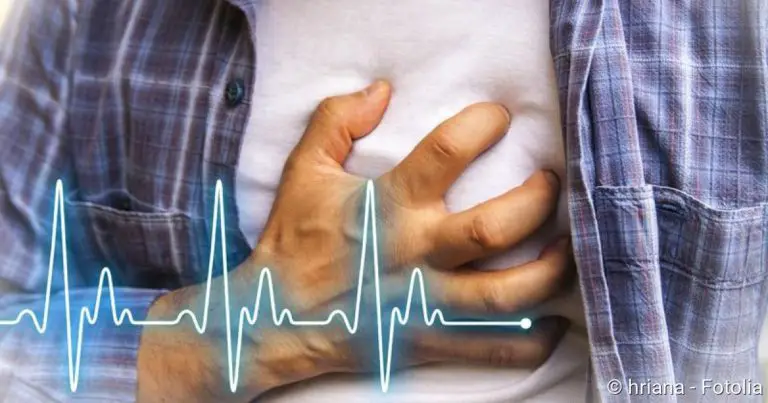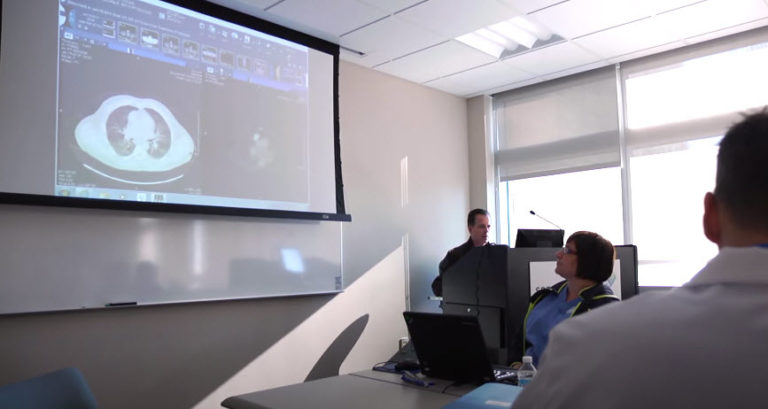Heart failure: causes, symptoms, treatment
Heart failure: causes, symptoms, treatment
In heart failure (weakness of the heart muscle, cardiac insufficiency, myocardial insufficiency) the heart is no longer able to supply the body with sufficient blood and thus oxygen. The disease is one of the most frequent causes of death. Read everything you need to know about: What is heart failure? What causes can it have? What are the symptoms? How is heart failure diagnosed and treated?

Heart failure: short overview
- Causes: in the first place narrowing of the coronary vessels (coronary heart disease), high blood pressure, heart muscle diseases (cardiomyopathies), inflammation of the heart muscle (myocarditis), heart valve defects, cardiac arrhythmia, chronic lung diseases, heart valve defects, heart attack, liver cirrhosis, drug side effects, increased blood fats, diabetes
- Symptoms: depending on the stage, dyspnea on exertion or at rest, reduced performance, fatigue, pale or blue discoloration of the lips and nail beds, oedema, especially on the ankles and lower legs, thickened neck vessels, rapid weight gain, nocturnal urination, racing heart, cardiac arrhythmia, low blood pressure
- Diagnostics: physical. Examination, blood pressure measurement, monitoring of heart and lungs, blood sampling with determination of the biochemical heart failure markers BNP (Brain Natriuretic Peptides), NT-proBNP, and MR-proANP (which are released via a stretch stimulus at the heart muscle), heart ultrasound, chest x-ray, ECG/long-term ECG, heart catheter
- Treatment: Drugs to lower blood pressure (antihypertensives), to flush out (diuretics), to slow down the heartbeat (e.g. beta blockers), to reduce the effect of certain hormones (aldosterone antagonists) and to strengthen the heart (e.g. digitalis). Depending on the cause operation (e.g. of the heart valves, bypass, pacemaker), sometimes heart transplantation.
Heart failure: causes and risk factors
In heart failure (cardiac insufficiency), the heart is no longer as efficient as a healthy heart. It can no longer supply the tissues of the body with sufficient blood (and thus oxygen). This could be life-threatening. Heart failure can have several causes:
The most common cause of heart failure is calcification of the coronary arteries (coronary heart disease, CHD). Due to the calcium plaques, the vessels supplying the heart muscle are constricted and the blood can no longer flow properly. As a result, the heart muscle is undersupplied and is no longer as efficient.
The second main cause is high blood pressure (hypertension). In the case of high blood pressure, the heart has to pump more strongly on a permanent basis, for example against narrowed vessels in the bloodstream. Over time, the heart muscle thickens to build up more pressure (hypertrophy). In the long term, however, it cannot withstand this load – and the pumping capacity decreases.
Other causes of heart failure are cardiac arrhythmia and myocarditis. Defects of the cardiac septum and heart valve defects (congenital or acquired) can also lead to heart failure. The same applies to fluid accumulation in the pericardium (pericardial effusion or pericardial effusion, especially in pericarditis).
Heart failure can also be caused by heart muscle diseases (cardiomyopathies). These in turn can be caused by inflammation or excessive alcohol, drug or medication abuse, for example. A special case is the so-called stress cardiomyopathy. This is when a severe traumatic event suddenly leads to life-threatening heart failure (usually in post-menopausal women). In this disease, also called Tako-Tsubo cardiomyopathy, the heart function usually returns to normal. This means that there is no permanent heart failure. Life expectancy and quality of life are therefore not impaired after surviving a stress cardiomyopathy.
Metabolic diseases can also play a role in the development of heart failure. Examples are diabetes mellitus (sugar disease) and thyroid dysfunction (such as hyperthyroidism = hyperthyroidism).
Lung diseases such as emphysema or COPD (chronic obstructive pulmonary disease) are other possible causes of heart failure. In particular, the less frequent right heart failure (functional weakness of the right side of the heart) can be due to lung disease. This is because the vessels in the diseased lung are usually also damaged. The blood can no longer flow through them properly (pulmonary hypertension). It jams back into the right heart and burdens it.
In some people, heart failure develops as a result of anemia or other organ diseases, such as liver or kidney disease. In rare cases, an AV fistula (AV shunt) leads to heart failure. It’s an abnormal short circuit between an artery and a vein.
Sometimes drugs also cause heart failure. This danger exists, for example, with certain drugs for cardiac arrhythmia, certain cancer drugs (antineoplastic drugs), appetite suppressants and migraine drugs (such as ergotamine). However, tumours of the heart or cancerous metastases may also cause cardiac insufficiency.
Systolic and diastolic heart failure
Heart failure generally consists of two parameters: systolic and diastolic heart failure.
The term systolic heart failure (also known as congestive heart failure) is used to describe the reduced pumping ability of the heart: The pumping function and the ejection capacity of the left ventricle are reduced. This leads to the organs no longer being supplied with sufficient blood. Besides, the blood is backing up. This causes oedema, for example in the arms and legs or in the lungs.
In addition to systolic heart failure, diastolic heart failure usually also occurs. This means that the heart chambers are no longer filled with blood sufficiently. In most cases, the left ventricle is pathologically altered and therefore less flexible and cannot absorb enough blood. As a result, less blood is pumped into the body’s circulation. This leads to an undersupply of oxygen to the body. Diastolic heart failure occurs mainly in old age. Women are more frequently affected than men.
Heart Failure: Classification
Heart failure can be classified according to various criteria:
- Depending on the affected heart area, a distinction is made between left heart failure, right heart failure and global heart failure (both halves of the heart are affected).
- Depending on the course of the disease, a distinction is made between acute heart failure and chronic heart failure.
- A rough classification according to the condition is that of compensated heart failure and decompensated heart failure.
- A more precise differentiation is provided by the NYHA Classification of Heart Failure, a classification of stages according to the degree of complaint, published by the New York Heart Association.
The European Heart Society (ESC) also classifies heart failure according to the ejection capacity of the heart. If the left heart continues to pump enough blood, doctors speak of a received ejection fraction (ejection fraction = EF, normal value 60-70%). This is in contrast to the reduced ejection rate. This results in the following classification:
- Heart failure with reduced left ventricular EF (HFrEF, EF<40%)
- Heart failure with moderate EF (HFmrEF, EF = 40-49%)
- Heart failure patient with received EF (HFpEF, EF is at least 50%)
Heart failure: left, right, global
In right heart failure, the right atrium and right ventricle of the heart muscle are particularly affected by the heart failure. The right side of the heart is the side to which the oxygen-deficient blood from the body is first directed. From there it pumps the blood further into the lungs to “tank” new oxygen. The enriched blood then flows into the left half of the heart and from there further into the body’s circulation.
A disease-related increase in pressure in the lungs leads to a backlog in the blood flow: the right ventricle of the heart must then pump the blood into the lungs with more force. Over time, the heart is overloaded and damaged (pulmonary heart/cor pulmonale). For example, excessive strain causes the muscle layer in the wall of the right ventricle to thicken.
If the right half of the heart can no longer provide the increased power, the blood accumulates in the supplying vessels (veins). The increased pressure in the veins causes water accumulation (edema) in the body, especially in the legs and abdomen.
Right heart failure usually develops as a result of chronic left heart failure.
In left heart failure, the pumping capacity of the left half of the heart is no longer sufficient. As a result, the blood congests back into the pulmonary vessels (congested lung). This is particularly dangerous as it can lead to water retention in the lungs (pulmonary oedema). Coughing and shortness of breath are typical symptoms.
When global heart failure is present, the pumping capacity of both parts of the heart is reduced. Symptoms of right and left heart failure are therefore evident.
The heart is divided into a right and left side. Oxygen-poor blood is pumped from the right side to the lungs and oxygen-rich blood is pumped from the left side back into the body.
Acute heart failure and chronic heart failure
In acute heart failure, the first symptoms appear very quickly within a few hours to a few days. The causes are usually other diseases. Chronic heart failure develops slowly over the course of several months to years.
Compensated and decompensated heart failure
The terms compensated heart failure and decompensated heart failure describe the cases in which symptoms occur. Compensated cardiac insufficiency usually only causes symptoms under stress. At rest, on the other hand, the heart is still able to perform the necessary work, so that no symptoms appear.
In contrast, decompensated heart failure causes symptoms such as water retention (edema) or shortness of breath (dyspnoea) even at rest or under low stress.
Doctors use the terms mainly when a heart failure is already known. If the symptoms are under control (for example, with the right medication), the heart failure is compensated. However, if this condition gets out of hand (e.g. due to acute additional diseases or lack of tablets), the heart failure is considered to be decompensated.
Heart failure: NYHA classification
The NYHA (New York Heart Association) has established a generally accepted classification of heart failure according to the observable symptoms:
- NYHA I: No physical symptoms at rest or under everyday stress.
- NYHA II: Slight limitations in physical exercise capacity (e.g. 2 flights of stairs), but no symptoms at rest yet.
- NYHA III: High restrictions even under everyday physical stress. Complaints such as exhaustion, cardiac arrhythmia, shortness of breath and “chest tightness” (angina pectoris) occur quickly even at low levels of stress.
- NYHA IV: Symptoms appear at any physical activity and at rest. Those affected are usually immobile (bedridden) and depend on permanent help in their daily lives.
Heart failure: Symptoms
Heart failure: symptoms of left heart failure
The left part of the heart is the part to which the blood is sent after it has been enriched with oxygen in the lungs. When this half of the heart no longer functions properly, the blood backs up into the lungs. This leads to coughing and shortness of breath (dyspnoea). In most cases, respiratory distress occurs initially only during exertion (stress dyspnea) and only later at rest (rest dyspnea). For many people affected, it is particularly noticeable at night when lying down, as the blood (and thus water) then flows back more easily to the weak heart.
Heart failure symptoms with “asthma cardiale”
If the left heart failure continues, fluid from the pulmonary capillaries passes into the alveoli. In addition to shortness of breath, this also leads to an increased irritation of the throat. At the same time, the bronchial tubes can become cramped. This complex of symptoms is also called “cardiac asthma” (“heart-related asthma”).
If fluid continues to enter the lung tissue, a so-called pulmonary edema develops. Its characteristics are severe shortness of breath and “blistering” breath sounds. The skin and mucous membranes become bluish (cyanosis) due to the lack of oxygen. Some patients then cough up foamy, sometimes flesh-coloured secretions. If fluid collects around the lungs in the pleural gap, doctors speak of a pleural effusion. It is also a possible heart failure symptom.
Because of the breathing problems, heart failure patients usually sit down instinctively with an upright and elevated upper body. This relieves the symptoms. In addition, the respiratory muscles can be used more effectively in this position.
Heart failure: symptoms of right heart failure
The oxygen-poor blood from the body flows into the right part of the heart. It is pumped from the right ventricle into the lungs, where it is enriched with oxygen again. When the right side of the heart is affected by the heart failure, the butt jams back into the body nerves. Typical heart failure symptoms in this case are water retention in the body (edema). They usually appear first in the legs (leg edemas) – especially at the ankles or on the back of the foot, then also above the shins. In bedridden patients, the edema usually first forms above the sacrum.
In the advanced stage of right heart failure, water also accumulates in the organs. Other typical heart failure symptoms are therefore impairment of organ functions. A congestion in the stomach (congestive gastritis) manifests itself, for example, by loss of appetite and nausea, a congestion of the liver by pain in the right upper abdomen. Fluid may also accumulate in the abdominal cavity (ascites, dropsy).
Water retention often causes rapid weight gain, often more than two kilos per week.
These swellings can dry out the skin because the pressure in the tissue becomes too great. Possible consequences are inflammations (eczema), which can develop into open, poorly healing wounds.
Global Heart Failure: Symptoms
If both halves of the heart are affected by the organ weakness, this is called global heart failure. The symptoms of both forms of disease (right and left heart weakness) then occur together.
Other heart failure symptoms
Heart failure causes water retention (edema) throughout the body. These are mainly solved (mobilized) at night, when the affected person is lying down. The body wants to excrete the released, excess fluid via the kidneys. This is why affected people often have to go to the toilet at night. This frequent nocturnal urination is called nocturia.
Especially in advanced stages of heart failure, breathing is disturbed. A common form is the so-called Cheyne-Stokes respiration. This can be recognized by the fact that the depth of breath and thus also the sound of breathing periodically increases and decreases. It occurs when the central nervous system is no longer properly supplied with blood due to advanced heart failure.
The heart beats very fast under stress (racing heart = tachycardia). In addition, cardiac dysrhythmia can occur, especially in cases of pronounced heart failure. The rhythm disturbances can become life-threatening and must then be treated immediately.
Another classic late stage heart failure sign is low blood pressure.
General and very common heart failure symptoms are also reduced performance, fatigue and exhaustion.
Heart failure: examinations and diagnosis
The diagnosis of heart failure is based on the recording of the patient’s medical history (anamnesis) and on physical and apparatus examinations.
In the anamnesis interview, the doctor asks the patient about his or her symptoms and whether heart diseases have already occurred in the family (genetic predisposition).
There are various possibilities for physical examination, which vary in terms of complexity and significance. The physical examination also serves to exclude other diseases that also cause heart failure symptoms such as shortness of breath and chest pain (differential diagnosis).
Listening to the heart activity with the stethoscope provides the doctor with first indications of a heart valve defect or a heart muscle weakness. When listening to the lungs, a rattling sound is a sign of heart failure. It indicates water retention in the lungs. However, rales also occur, for example, with pneumonia. Under certain circumstances the doctor may also hear a third heartbeat (this is otherwise only normal in children and adolescents).
In the case of oedema in the legs, visible dents can be pressed into the skin. If the doctor measures the pulse, it may change its intensity with each beat (pulsus alternans). Furthermore, the examiner recognizes protruding neck veins – signs of a blood backlog.
The function of the heart can be assessed with a cardiac ultrasound (echocardiography). The doctor can see whether there are defects in the valves, in the structure of the heart walls or in the interior of the heart. A thickened wall structure and the ejection performance of the heart are also made visible in this way.
The blood flow that flows through the heart can be visualized using color Doppler sonography. This is a special form of ultrasound examination. Using an ultrasound device, the doctor can also see accumulations of fluid in the abdomen (ascites) or chest (pleural effusions). At the same time he checks the vena cava and organs for signs of congestion.
Cardiac arrhythmias are best detected with a long-term ECG. The affected person is given a small portable device to take home. It is connected to the electrodes that the doctor places over the patient’s chest and continuously records heart activity. A long-term ECG usually runs for 24 hours. The examination is painless and does not affect the patient.
With a cardiac catheter examination, the doctor can check whether narrowed coronary vessels are causing the heart failure. The examination usually takes place under local anaesthetic. If constricted areas are detected, they can be expanded immediately. Under certain circumstances stents (vessel supports) are used to keep the coronary vessel permanently open. Exercise tests (e.g. on a bicycle ergometer) also help to assess the extent of the problem. In some cases the heart is so weak that these tests are no longer possible.
A blood pressure measurement is also taken if heart failure is suspected. The doctor also orders various urine and blood tests in the laboratory. Among other things, the urine status and a blood count are made. The electrolytes (especially sodium and potassium) are also determined. Various organ parameters such as creatinine, fasting blood glucose, liver enzymes including coagulation values and the protein brain natriuretic peptide (BNP, also NT-proBNP) are also measured. In fact, heart failure leads to an increase in BNP levels, as it is released when the heart is overstretched and stressed. This value is closely related to the severity of heart failure (NYHA classification).
With the help of these tests, it is also possible to detect disorders of the liver, kidney or thyroid gland, for example. Elevated blood fat values and diabetes mellitus can also be diagnosed in this way.
In addition, chest x-rays and magnetic resonance imaging (MRI) can support the diagnosis of heart failure.
Heart failure: treatment
Heart failure therapy consists of several components and depends mainly on the severity of the heart failure. In principle, in addition to drug therapy, the personal lifestyle is also decisive. In severe cases of illness a pacemaker or heart transplantation may be necessary.
In general, heart failure is a progressive disease that often leads to death. The therapy guidelines of international professional associations therefore recommend palliative care for all patients. On the one hand, this includes the alleviation of symptoms (e.g. with medication or a surgical intervention). On the other hand, this also includes intensive communication between doctor and patient: everything important about diagnosis, therapy, course and prognosis of the disease should be discussed together. One should also take care of preventive powers of attorney and living wills. This makes it easier for the patient and his relatives to deal with the disease.
Heart failure: medication
Drug therapy for heart failure is aimed at preventing complications of the disease and improving the quality of life of patients. Depending on the cause of the heart failure, different medications are used. Some medications have been shown to improve the prognosis, while others primarily alleviate existing complaints.
Very often, active ingredients from the group of ACE inhibitors (first choice) and beta blockers are used in heart failure therapy. According to the latest studies they have a life-prolonging effect. In order for these and other medicines to work properly, however, they must be taken permanently and regularly as prescribed by the doctor.
Overall, there are various active ingredients available for heart failure therapy. Among the most important are:
- ACE inhibitors: They block a protein that is responsible for narrowing the blood vessels in the body. As a result, the blood vessels remain permanently dilated and the blood pressure drops. This relieves the heart and the rebuilding of the heart muscle as a result of permanent overload is slowed down. ACE inhibitors are usually prescribed by the doctor first (NYHA I).
- AT-1 antagonists (Sartane): They block the action of a blood pressure-increasing hormone. However, they are only used if the patient cannot tolerate ACE inhibitors.
- Beta-blockers (beta-receptor blockers): They lower blood pressure and pulse, prevent life-threatening arrhythmias and thus improve the prognosis of heart failure. They are usually used from NYHA Stage II onwards, but also earlier if, for example, a heart attack has occurred.
- Mineralocorticoid receptor antagonists (MRA): These are additionally indicated in NYHA stages II-IV, especially when the heart is no longer pumping sufficiently (EF<35%). They increase water excretion from the body, which ultimately relieves the heart. This treatment, as an “antifibrotic therapy”, is intended to contribute to a reversal of the harmful heart muscle remodelling.
- Sacubitrile/Valsartan: This combination of active ingredients is only prescribed in certain cases of chronic heart failure. Sacubitrile is a so-called neprilysin inhibitor and thus inhibits the breakdown of hormones in the body that dilate the blood vessels. Valsartan cancels the effect of the blood pressure-increasing hormone angiotensin.
- Ivabradine: This medicine lowers the heart rate. Doctors prescribe it if the heartbeat is too fast (>70/min) even under beta-blockers or if they are not tolerated.
- Digitalis: Preparations with Digitalis improve the pumping power of the heart. It does not prolong life, but increases the quality of life and the resilience of those affected. Digitalis (digitoxin, digoxin) is used to control the frequency of atrial fibrillation, a frequent cardiac arrhythmia.
- Diuretics: Diuretics are diuretic drugs. They excrete stored fluid, so that the heart and vessels are less stressed. They are therefore always used when the patient is suffering from edema.
- According to the new European guidelines on heart failure, standard therapy includes diuretics, ACE inhibitors and beta-blockers, and in NYHA Stages II-IV additionally MRA.
Every medication can also have side effects. A common side effect of ACE inhibitors, for example, is chesty cough. However, this is usually harmless. AT1 antagonists and diuretics can upset the blood-salt balance, beta-blockers can severely slow down the heartbeat. If patients with heart failure suffer from drug side effects, they should inform their doctor. This person can adjust the dosage or possibly even prescribe a different preparation.
Hawthorn for heart failure
Herbal medicine recommends hawthorn preparations for heart failure. They are intended to improve the contractility and oxygen supply to the heart muscle. They also counteract cardiac arrhythmia (antiarrhythmic effect). From a scientific point of view, no relevant and proven efficacy of hawthorn in heart failure has been demonstrated to date. If patients still wish to try such medicinal plant preparations, they should do so in consultation with their doctor or pharmacist and in addition to conventional heart failure treatment.
Iron substitution by infusion is indicated if the ferritin value is below 100 micrograms per liter or the transferrin saturation is below 20 percent. This measure may facilitate breathing. This is because iron is a basic component of our oxygen transporters in the blood, the red blood cells (erythrocytes). Iron deficiency sooner or later leads to anaemia, which promotes heart failure.
Hawthorn for heart failure: Hawthorn extracts are said to increase the contractility of the heart, improve the oxygen supply to the heart muscle and have an antiarrhythmic effect.
Pacemaker against heart failure
In people with advanced heart failure, a so-called biventricular pacemaker (CRT = cardiac resynchronization therapy) can be combined with drug therapy. Both together can compensate for the heart failure. In CRT, pacemaker wires are inserted into the ventricles of the heart so that they beat in the same rhythm again.
Patients who have survived a cardiac arrest or suffer from dangerous cardiac arrhythmia benefit from an implantable defibrillator (Implantable Cardioverter/Defibrillator, ICD). The device is used like a pacemaker. It delivers an electric shock when it detects a dangerous rhythm disturbance.
Sometimes doctors also use a combination device of both systems, the so-called CRT-ICD system (also CRT-D system).
Surgical measures
If heart failure worsens despite existing therapy, it may become necessary to replace the old heart with a new one (heart transplantation). Patients can receive a donor heart or an artificial heart. This can lead to various complications such as rejection reactions.
Narrowed coronary arteries (coronary heart disease, CHD) are among the most common causes of heart failure. The impaired blood flow can be surgically improved by dilating the vessels during a cardiac catheter examination (balloon dilatation, possibly with installation of a stent = vessel support). You can also do a bypass.
If defective heart valves are the cause of heart failure, surgery may also be necessary. Sometimes a “repair” (reconstruction) of the heart valve is possible. In other cases, the defective heart valve is replaced (biological or mechanical valve prosthesis).
Heart failure: What you can do yourself
If the doctor has diagnosed you with heart failure, you should make sure you lead a healthy lifestyle. Risk factors are thus minimized and the quality of life is increased. You should therefore take the following to heart:
- Nutrition: Make sure you eat a diet with sufficient fruit and vegetables. Avoid animal fats if possible and eat low-salt food. Salt ensures that water is stored in the body. The heart must then work harder.
- Fluid intake: You should discuss the amount of daily fluid intake with your doctor. In general, if you suffer from heart failure, you should never drink three or more litres a day. In most cases, a fluid intake of about 1.5 litres per day is ideal.
- Move: Effective heart failure therapy always includes exercise and moderate physical activity. In everyday life, for example, you can walk to work and take the stairs instead of the elevator. Walks, light strength and coordination exercises, swimming, cycling and walking are also recommended. You can also join a sports group for heart patients (rehabilitation sports). Discuss with your doctor which physical activities and sports are appropriate in your case and to what extent you may exercise.
- Body weight: Being overweight has a strong negative effect on heart failure. From a body mass index (BMI) over 40, weight should be reduced without hesitation. Weight loss should be controlled and slow and in any case under the supervision of a doctor. Normal-weight heart failure patients should also check their weight regularly, preferably daily. A very rapid and large weight gain can be an indication of water retention in the body. Rule of thumb: If you gain more than one kilo in weight per night, more than two kilos in three nights or more than 2.5 kilos in one week, it is essential that you see a doctor.
- Alcohol: Minimize your alcohol consumption, because alcohol can damage the heart muscle cells. Women are recommended to consume no more than twelve grams of pure alcohol (a standard drink) per day. Men should not drink more than 24 grams of pure alcohol (equivalent to two standard drinks) per day. Patients whose heart failure was caused by excessive alcohol consumption (alcohol-toxic cardiomyopathy) should avoid alcohol altogether.
- Smoking: It is best to give up smoking completely!
- Vaccination: Get vaccinated regularly every year against influenza and every six years against pneumococcus.
- Diary: Keep a diary of any complaints you notice. This way you will not forget anything at your next visit to the doctor.
Heart failure: course of disease and prognosis
Heart failure is not curable. Only in a few cases can the symptoms be reduced to such an extent that a completely unimpaired life is possible. However, each patient can influence whether and how far the disease progresses. By changing their lifestyle and dealing with the disease consciously, those affected can do much to improve their prognosis.
In addition to lifestyle, it is above all compliance that patients must observe. By therapy compliance, the doctor describes the extent to which patients adhere to the prescribed and discussed therapy. This includes, for example, that the prescribed medication is taken regularly, even though there may be no symptoms at the moment. Complications and deterioration of the general condition can thus be prevented in advance.
Compliance also includes regular check-ups with the family doctor. If blood values (e.g. electrolytes, kidney values) are outside the normal range, more frequent checks are necessary.
Also important for heart failure: If you suspect that your condition has worsened, consult your doctor immediately!
Heart failure: life expectancy
Statistically, half of all patients die within five years of being diagnosed with “heart failure”. However, life expectancy and quality of life of patients have increased in recent years due to the ever-improving medical care. Those affected now have a better prognosis and a comparatively high life expectancy despite the disease. In individual cases, this depends on the type (genesis) of the disease, the age of the person affected, possible concomitant diseases and personal lifestyle.
On death certificates, “heart failure” is often given as the cause of death. This refers to acute heart failure, which in many cases leads to death.





